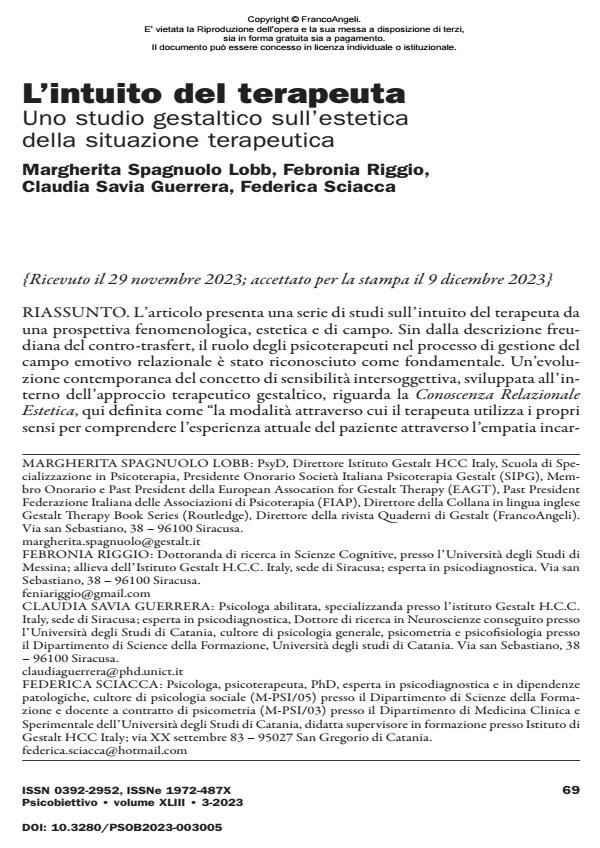L’intuito del terapeuta. Uno studio gestaltico sull’estetica della situazione terapeutica
Titolo Rivista PSICOBIETTIVO
Autori/Curatori Margherita Spagnuolo Lobb, Febronia Riggio, Claudia Savia Guerrera, Federica Sciacca
Anno di pubblicazione 2024 Fascicolo 2023/3
Lingua Italiano Numero pagine 16 P. 69-84 Dimensione file 660 KB
DOI 10.3280/PSOB2023-003005
Il DOI è il codice a barre della proprietà intellettuale: per saperne di più
clicca qui
Qui sotto puoi vedere in anteprima la prima pagina di questo articolo.
Se questo articolo ti interessa, lo puoi acquistare (e scaricare in formato pdf) seguendo le facili indicazioni per acquistare il download credit. Acquista Download Credits per scaricare questo Articolo in formato PDF

FrancoAngeli è membro della Publishers International Linking Association, Inc (PILA)associazione indipendente e non profit per facilitare (attraverso i servizi tecnologici implementati da CrossRef.org) l’accesso degli studiosi ai contenuti digitali nelle pubblicazioni professionali e scientifiche
L’articolo presenta una serie di studi sull’intuito del terapeuta da una prospettiva fenomenologica, estetica e di campo. Sin dalla descrizione freudiana del contro-trasfert, il ruolo degli psicoterapeuti nel processo di gestione del campo emotivo relazionale è stato riconosciuto come fondamentale. Un’evoluzione contemporanea del concetto di sensibilità intersoggettiva, sviluppata all’interno dell’approccio terapeutico gestaltico, riguarda la Conoscenza Relazionale Estetica, qui definita come “la modalità attraverso cui il terapeuta utilizza i propri sensi per comprendere l’esperienza attuale del paziente attraverso l’empatia incarnata e la risonanza”. Vengono descritti tre studi su questo costrutto, che hanno sviluppato e validato una scala per descrivere l’intuito del terapeuta in questa specifica prospettiva, i cui fattori chiave sono la risonanza, la consapevolezza corporea e l’empatia. I risultati suggeriscono implicazioni significative per la formazione degli psicoterapeuti e per la supervisione, evidenziando l’importanza del lavoro sui processi corporei e della capacità relazionale estetica nel lavoro con i pazienti.
Parole chiave:Intuition, Phenomenological Perspective; Gestalt Psychotherapy; Aesthetic Relational Knowledge (ARK); Therapist Training
- La supervisione in psicoterapia della Gestalt Margherita Spagnuolo Lobb, in QUADERNI DI GESTALT 1/2024 pp.7
DOI: 10.3280/qg2024-1oa17950
Margherita Spagnuolo Lobb, Febronia Riggio, Claudia Savia Guerrera, Federica Sciacca, L’intuito del terapeuta. Uno studio gestaltico sull’estetica della situazione terapeutica in "PSICOBIETTIVO" 3/2023, pp 69-84, DOI: 10.3280/PSOB2023-003005